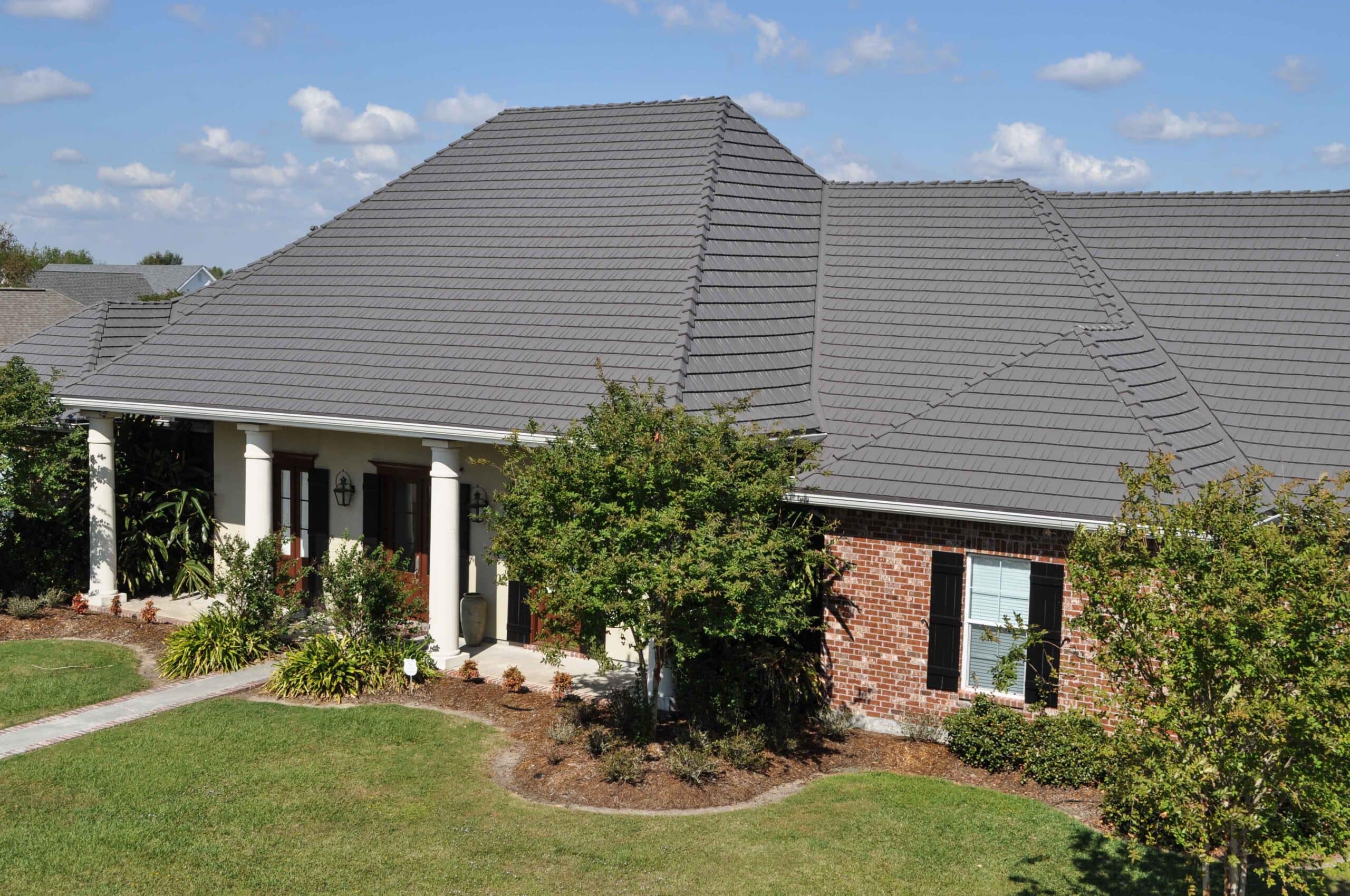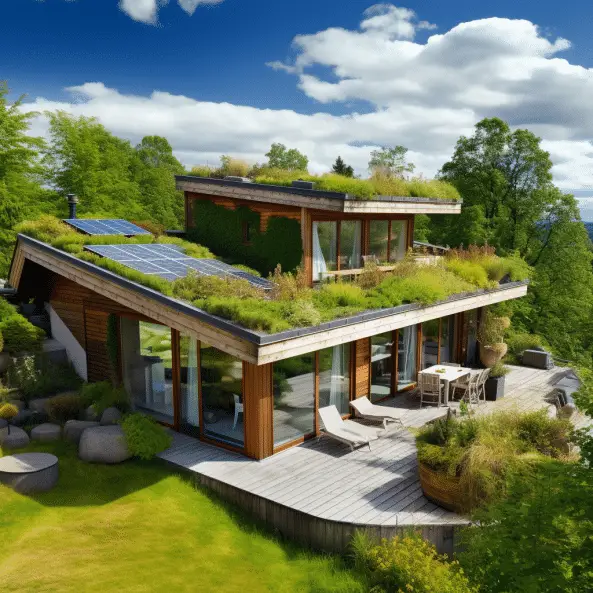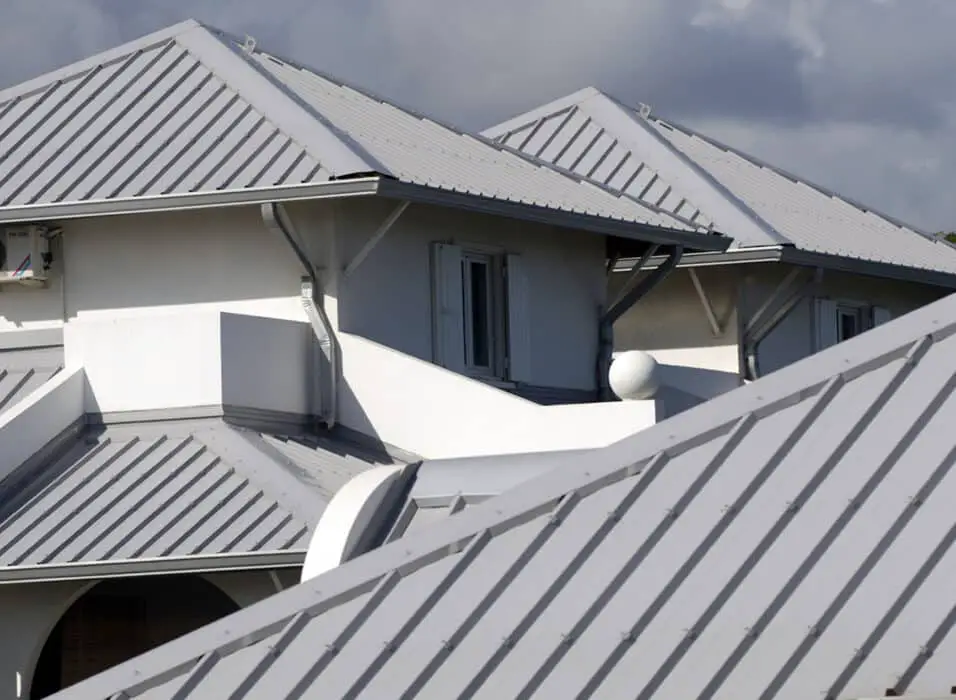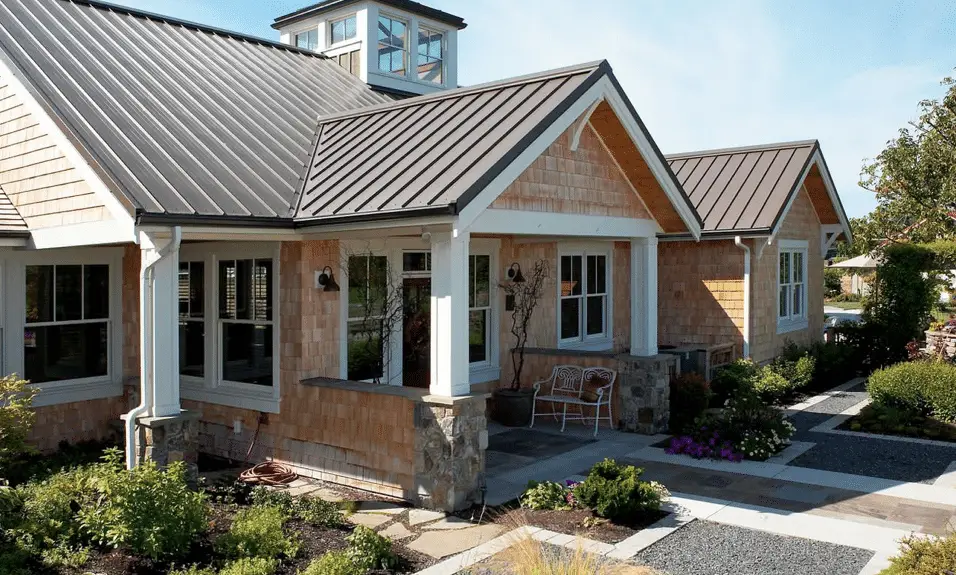What Is The Minimum Slope For A Metal Roof
Introduction
What Is The Minimum Slope For A Metal Roof: The minimum slope for a metal roof: Due to its durability, endurance, and aesthetic appeal, metal roofs have become very popular. Understanding the aspects that affect metal roofing installation and performance is important as homeowners and builders choose it more. The minimal slope necessary for a metal roof affects its functionality and longevity.
The minimal slope for a metal roof is typically ¼:12, meaning it rises ¼ inch vertically for every horizontal foot. Metal roofs can be put on low-slope roofs, making them suitable for residential and commercial use. Before installation, check the manufacturer’s slope requirements for your metal roofing product.
One of the primary reasons for the low minimum slope requirement of metal roofs is their ability to shed water efficiently. Metal roofing systems are designed with interlocking panels or standing seams that create a watertight barrier, preventing water from seeping through the roof surface. Additionally, the smooth surface of metal roofs allows water to flow easily, reducing the risk of water pooling or leakage.
The minimum slope required for a metal roof is typically ¼:12, making it suitable for a wide range of applications. Metal roofs offer numerous advantages, including durability, longevity, and resistance to various weather conditions. However, it is essential to consider the specific requirements of the metal roofing system being used and consult the manufacturer’s guidelines to ensure proper installation and optimal performance. By understanding the importance of slope in metal roof installations, homeowners and builders can make informed decisions and enjoy the benefits of a reliable and long-lasting roofing solution.

What is the standard angle for a metal roof?
Minimum Roof Slope
The most common slopes are 3:12, 1/2:12, and 1/4:12. Check with the manufacturer before buying a metal roofing panel to make sure it will work for your application.
Metal roofs are popular with homeowners due to its durability, endurance, and aesthetics. Installation of a metal roof requires consideration of the typical angle. The angle of a metal roof impacts its ability to shed water, withstand wind uplift, and prevent snow buildup. This article discusses metal roof standard angles and their determinants.
Influences on standard angle:
The usual metal roof angle depends on climate, roof pitch, and local building standards. To shed water and snow, higher roof pitches are recommended in areas with heavy rainfall or snowfall. This decreases water leaks and snow damage to structures. A steeper roof pitch minimizes wind uplift and enhances stability, improving wind resistance.
Considerations for climate:
A roof pitch of at least 6:12 (6 inches of vertical rise for every 12 inches of horizontal run) is suggested in places with heavy rain or snow. This pitch sheds water and snow, preventing leaks and structural damage. In dry climates or areas without snow buildup, a lower roof pitch may be acceptable.
Roof pitch, aesthetics:
The roof pitch impacts metal roof looks as well as functionality. Lower pitches are sleeker and more modern, whereas steeper pitches are more dramatic. Roof pitch depends on the homeowner’s preferences and the building’s architecture.
Local construction codes:
In some regions, municipal construction codes set the minimum metal roof pitch. Building safety and structural integrity are ensured by these codes. Thus, you must consult local authorities or a roofing contractor to determine your location’s regulations.
Climate, roof pitch, and local construction codes affect metal roof angles. Careful angle selection ensures water and snow shearing efficiency.
What is the minimum slope for roof?
Asphalt shingles typically have a 2:12 roof slope.
Slope matters when roofing. Roof slope is its angle for building. It considerably impacts roof durability and performance. Understand the minimal roof slope for drainage, weather resistance, and structural integrity.
Roof Slope Importance:
Roof slope helps drain water. Snow and other waste don’t accumulate on steep roofs. This keeps water out of the roof and prevents leaks, rot, and other damage. Well-designed slopes prevent winter ice jams, reducing water infiltration.
Lowest slope factors:
The roofing material, environment, and building needs determine the minimum roof slope. Certain roofing materials require specific slopes. Asphalt shingles need a 4:12 roof slope. Metal roofs can have a lower minimum slope since they shed water.
Considerations: Structure
The minimal roof slope considers building structure. Steeper slopes require more roof support to withstand weight and wind uplift. In areas with heavy snowfall or high winds, a higher slope may improve roof stability and lifespan. Minimum slope requirements are specified by building codes for roof safety and durability.
The minimal roof slope is essential to roof design and construction. The roof’s drainage, weather resilience, and structure are affected. The roof material, environment, and building codes determine the minimum slope. Follow local rules and consult roofing professionals to assess a roof’s minimal slope. Consider these variables to create a sturdy, building-protecting roof.
What is the maximum slope for a metal roof?
For 3/12 to 7/12 pitches, use snap-lock metal roofing. Good thing most roofs are 4/12 to 9/12 pitched.
Understanding maximum slope:
Residential metal roofs are popular due to their durability, endurance, and beauty. Installing a metal roof necessitates considering its maximum slope. The steepness or angle of the roof determined its performance and function. We’ll discuss metal roof maximum slope and installation in this section.
The steepest angle for erecting a metal roof without leaking or affecting its structure. In ratios like 1:12 or 4:12, the first number represents the vertical ascent and the second the horizontal run. Every 12 units horizontally, a 4:12 slope increases the roof 4 units vertically.
Highest slope factors:
A metal roof’s maximum slope relies on various factors. Roof metal matters. High slope resistance may depend on metal flexibility and strength. Profile or form of metal panels is also essential. Some profiles suit short slopes, others high angles.
Maximum slope matters:
For many reasons, metal roof maximum slope recommendations must be understood and followed. First, exceeding the recommended slope may undermine the roof, triggering collapses or damage in extreme weather. Second, a poorly sloped roof might leak and damage the structure. Lastly, following the manufacturer’s maximum slope restrictions protects the metal roof’s guarantee and functionality.
Installing a metal roof necessitates considering its maximum slope. It finds the steepest roof installation angle for structural integrity and water resistance. Metal type and panel profile determine maximum slope. The required slope affects metal roof performance, longevity, and warranty.
What is the ratio of slope to roof?
Slope Ratio
The difference between rise and run determines a roof’s slope as a ratio. Example: A roof with 4 feet of rise and 12 feet of run has a 4:12 slope. This is slope ratio.
The slope-to-roof ratio is crucial to architecture and construction. It describes the relationship between roof steepness and design. The utility, aesthetics, and structural integrity of a structure depend on this ratio. Architecture and engineering can make better design and construction decisions by knowing the slope-to-roof ratio.
Slope-to-roof ratio importance:
Slope-to-roof ratio matters for various reasons. First, it influences building drainage. Rainwater and snow roll off a steeper roof, preventing damage. However, a flatter slope may need gutters and downspouts for drainage.
Second, slope-to-roof ratio affects building aesthetics. Traditional and modern architecture can be created via roof slopes. A high slope is linked with historic European architecture, while a flat or low slope is common in modern architecture.
Influences on slope-to-roof ratio:
Several factors affect slope-to-roof ratio. Climate is an important factor in building location. Heavy rains or snowfall may demand higher slopes to allow water drainage and prevent roof damage from weight.
Also important is the roofing material. Clay tiles and metal sheets may need certain slope ratios for installation and durability. The optimal slope-to-roof ratio also depends on the building owner or designer’s architectural style and design choices.
The slope-to-roof ratio is vital to architectural and construction design. It impacts building functionality and aesthetics. To calculate the best slope-to-roof ratio for each project, architects and engineers must consider climate, roofing materials, and design preferences. This assures drainage, structural integrity, and building aesthetics. Understanding this ratio helps experts build safe, efficient, and attractive structures.
What is the minimum slope for water flow?
Using a minimum slope of 2% will encourage a good flow when directing water to a rain garden. For a 2% slope your pipe height will lower ~¼ inch for every foot of length. You can also approximate this by multiplying the pipe length in inches by . 02.
Introduction:
Water flows naturally from higher to lower elevations. A minimal slope for water flow is essential in hydrology, engineering, and the environment. It manages water flow, drainage, irrigation, and river network planning.
The threshold slope is the lowest gradient needed for water to flow over friction and gravity. Channel roughness, water viscosity, and obstructions affect water flow. Steeper slopes transport water faster, which may stagnate it.
The minimum water flow slope is fundamental to hydraulic engineering. It depicts vertical height decline over horizontal distance as a ratio or percentage. The height declines 1 meter per 100 meters horizontally on a 1% slope. This slope helps water flow in canals and ditches.
Minimum slope affects stormwater runoff and drainage. In urban areas where roads and buildings prevent natural infiltration, stormwater must be efficiently conveyed to reduce flooding and waterlogging.
Water flow minimum slope is essential in environmental study
River management, and engineering. It affects water velocity, energy, sediment transport, erosion, and riverbed development. The minimum slope needed for water flow is essential for river ecosystems, sedimentation control, and aquatic habitats.
The minimum slope for a metal roof depends on many factors to ensure its durability. Major consideration is metal roofing. Metal materials have different qualities and constraints, determining minimum slope. The minimum slope for standing seam metal roofs is 3:12, however corrugated roofs may need 1:12.
The minimal slope depends on local weather and surroundings. Heavy rains and snowfall require higher slopes to drain water and prevent roof leaks. The minimum slope depends on roof size and shape. Larger roofs may need steeper slopes for water drainage and structural strength.
Finally, a metal roof’s minimum slope depends on its material, environment, size, and shape. Following these minimum slope requirements is crucial.
How does the material composition of a metal roof affect its minimum slope requirement?
The material composition of a metal roof plays a crucial role in determining its minimum slope requirement. Different types of metal roofing materials have varying characteristics that directly impact their ability to shed water and resist potential leaks. These characteristics include the metal’s strength, flexibility, and resistance to corrosion.
Strength is an important factor when considering the minimum slope requirement for a metal roof. Metal roofs with higher strength can withstand greater loads, including the weight of accumulated snow or debris. Therefore, roofs made from stronger metals may have a lower minimum slope requirement as they can handle heavier loads without compromising their structural integrity.
Flexibility is another key consideration. Metal roofs that are more flexible can better adapt to the natural movement and settling of a building. This flexibility allows the roof to accommodate any minor changes in the underlying structure, reducing the risk of leaks or damage. As a result, metal roofs with higher flexibility may have a slightly lower minimum slope requirement.
Resistance to corrosion is also a critical factor in determining the minimum slope requirement for a metal roof. Metal roofs that are highly resistant to corrosion can withstand exposure to moisture, chemicals, and other environmental factors without deteriorating. This resistance ensures the long-term durability of the roof and reduces the likelihood of leaks. Therefore, metal roofs with superior corrosion resistance may have a lower minimum slope requirement.
Are there any building codes or regulations that specify the minimum slope for metal roofs?
Yes, there are building codes and regulations that specify the minimum slope for metal roofs. The specific minimum slope requirement may vary depending on the location and climate, as different regions may have different weather conditions and precipitation levels.
Building codes typically provide guidelines for the minimum slope required for different types of roofs, including metal roofs. The minimum slope requirement is usually expressed as a ratio, such as 1:12 or 2:12, which represents the vertical rise of the roof per horizontal distance. For example, a 1:12 slope means that for every 12 units of horizontal distance, the roof should rise by 1 unit vertically. This slope requirement helps ensure proper water drainage and prevents water from pooling on the roof, which can lead to leaks and other water-related damage.
Can the minimum slope for a metal roof vary depending on the climate or geographical location?
Yes, the minimum slope for a metal roof can vary depending on the climate or geographical location. This is because a flatter roof can lead to water pooling, which can eventually result in leaks, structural damage, or even roof collapse.
Additionally, the geographical location can also play a role in determining the minimum slope for a metal roof. Areas prone to high winds, such as coastal regions or hurricane-prone zones, may require a steeper slope to withstand the force of the wind and prevent wind-driven rain from infiltrating the roof. On the other hand, regions with a dry climate or low precipitation levels may have less stringent slope requirements since water drainage is not as critical.
It is important to consult local building codes and regulations to determine the specific minimum slope requirements for metal roofs in a particular climate or geographical location. These codes are put in place to ensure the safety and longevity of the roof, as well as to comply with regional weather conditions. Failing to meet the minimum slope requirements can result in a variety of issues, including water damage, structural problems, and potential voiding of warranties.
Can the minimum slope for a metal roof vary depending on the climate or geographical location?
Yes, the minimum slope for a metal roof can vary depending on the climate or geographical location. The slope of a roof is primarily determined by the need to effectively shed water and prevent water pooling or leakage. Different climates and geographical locations experience varying levels of rainfall, snowfall, and wind, which can impact the minimum slope requirement for a metal roof.
In areas with high rainfall or heavy snowfall, a steeper slope is typically recommended to ensure efficient water drainage and prevent water from accumulating on the roof. This helps to minimize the risk of leaks, water damage, and structural issues. Similarly, in regions prone to strong winds, a higher slope may be necessary to enhance the roof’s resistance to uplift forces.
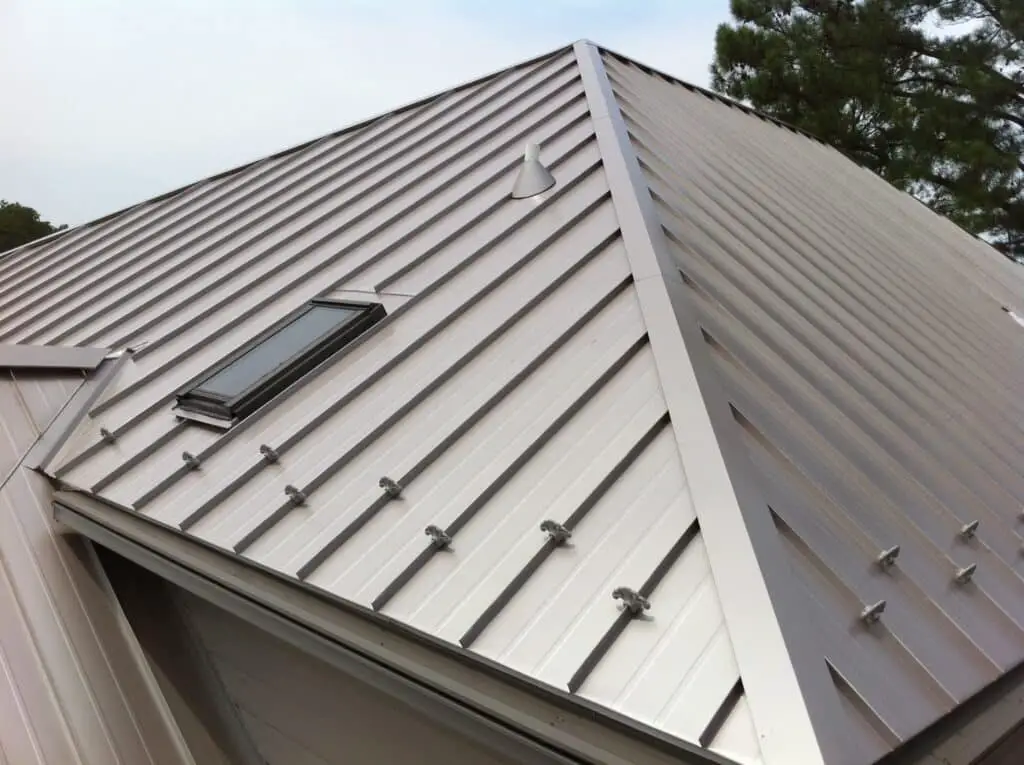
Conclusion
Different metals have different characteristics and limitations. For example, standing seam metal roofs, which are popular for their sleek appearance and superior waterproofing, typically require a minimum slope of 3:12 to ensure proper performance. On the other hand, corrugated metal roofs may have a lower minimum slope requirement due to their design and installation method.
Lastly, the climate conditions of the area play a crucial role in determining the minimum slope for a metal roof. Regions with heavy rainfall or snowfall may require a steeper slope to facilitate efficient water and snow shedding. Additionally, areas prone to high winds may benefit from a higher slope to minimize the risk of wind uplift and damage to the roof. Consulting with a local roofing professional or considering regional building codes can provide valuable insights into the specific slope requirements for a metal roof in a particular area.
While there is no definitive answer to the minimum metal roof slope , it is generally recommended to have a minimum slope of 1:12 for most metal roofing systems. This slope ensures proper water drainage, reduces the risk of leaks and structural damage, and allows for efficient shedding of snow and debris. However, it is important to consider the type of metal being used and the climate conditions of the area when determining the specific slope requirements. Consulting with a roofing professional and adhering to local building codes can help ensure the longevity and performance of a metal roof.



